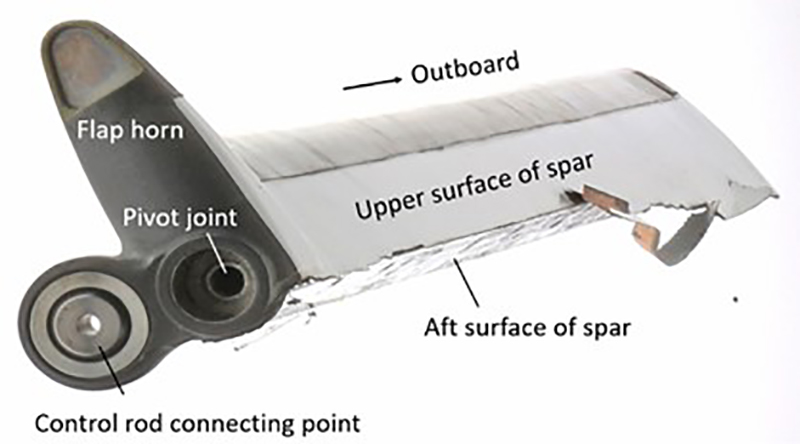July 19, 2023
Director General, Civil Aviation
Transport Canada
Subject :
Air Transportation Safety Advisory Letter A21P0107-D1-A1
Kaman K-1200 helicopter servo flap failure
On 04 October 2021, the Black Tusk Helicopter Incorporated Kaman K-1200 helicopter (registration C-FZVM, serial number A-94-0053) was conducting helicopter logging operations in the vicinity of Killam Bay in Jervis Inlet, British Columbia. At approximately 1302 Pacific Daylight Time, the pilot, who was alone on board, was transporting logs from a cut block to an ocean log pen approximately 0.6 nautical miles to the northwest. After releasing 3 logs into the log pen from the grapple, the aircraft entered a slow 180° turn, and initiated a climb to return to the cut block. The aircraft then entered a rapid descent and impacted the water within the log pen and sank. The helicopter was located using sonar 8 days after the occurrence and was subsequently recovered. The pilot was fatally injured. The TSB investigation into this occurrence (A21P0107) is ongoing.
Following the accident, the investigation recovered 3 of the 4 servo flaps. The aft body of one of those servo flaps (rotor blade 517B) had separated from the spar and the body was not recovered.
Servo flaps are the flight control surfaces attached to each of the 4 main rotor blades. The flaps are a monocoque structure with a symmetrical airfoil shape and are made primarily of carbon fibre. The flaps are deflected by the pilot controls and produce an aerodynamic force that imparts a torsional (twisting) moment to the rotor blade and creates the required angle of attack for lift. In the case of an in-flight failure of a servo flap, the affected blade will become aerodynamically neutral and produce negligible lift, which will result in an out-of-track condition of the main rotor blades and an imbalance in the rotor system.
The recovered portion of the servo flap from rotor blade 517B (Figure 1) was examined macroscopically and microscopically by the TSB Engineering Laboratory in Ottawa, Ontario. Signs of fracture surface rubbing, fibre end erosion, and foreign material deposition were found, which indicates that the flap experienced fatigue/progressive fractures before the occurrence. The fractures propagated from the inboard end to the outboard end, with the final separation indicative of catastrophic failure due to flutter.
A second servo flap from the occurrence helicopter was also examined at the TSB laboratory and was found to have a similar crack between the spar and aft body. The aft body had not separated.
Testing data generated by the original equipment manufacturer, both during certification and during a post-accident investigation, showed that the climbing (take-off power / high rpm) phase of flight significantly increases the vibratory load on the servo flap of the rotor system. However, the timeline for the progression of the flap fractures to a catastrophic failure is unknown, and the contribution of flight loading from the phase of flight and pilot input needs further examination.
The Kaman Model K-1200 K-MAX Maintenance and Servicing Instructions require a visual inspection of the servo flap before every flight, and a detailed visual inspection with the flap removed every 100 hours, or annually. No cracks are allowed in the flap skins and flap horn.Footnote 1
The U.S. National Transportation Safety Board (NTSB) investigated 2 accidents—one in 2010 and the other in 2020—that involved the catastrophic failure of the Kaman K-1200 main rotor systems. In both accidents, the helicopter was destroyed, and the pilot fatally injured. In each case, investigators found that the aft body of 1 servo flap had separated from the spar and, in the 2020 case, there was evidence of a progressive crack that initiated at the inboard end before propagating outboard.
The TSB laboratory collaborated with the NTSB in comparing the evidence gathered from each investigation and discussing the failure initiating mechanisms. In addition, the manufacturer was briefed on the initial findings, and engaged for engineering expertise and design of the servo flap. The TSB has not been made aware of any mitigating actions or strategies taken by the manufacturer following these occurrences.
The TSB is raising this issue for your awareness and for any action you deem necessary. The TSB would appreciate being advised of any action that is taken in this regard.
Upon completion of investigation A21P0107, the Board will release its investigation report into this occurrence.
Yours sincerely,
Original signed by
Natacha Van Themsche
Director of Investigations – Air
Transportation Safety Board of Canada
cc:
- Associate Administrator for Aviation Safety, Federal Aviation Administration
- Executive Director, Aircraft Certification Service, Federal Aviation Administration
- Director, Office of Aviation Safety, National Transportation Safety Board
- Senior Aviation Accident Investigator, Accredited Representative, National Transportation Safety Board
- President, Air Vehicles & Precision Products, Kaman
- General Manager of Air Vehicles Division, Kaman
- Director, Safety Policy and Intelligence – Civil Aviation, Transport Canada
- Standards Coordinator - Airworthiness, Minister’s Observer, Transport Canada
- Operations Manager, Black Tusk Helicopters
